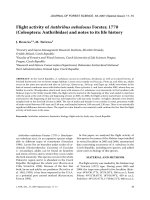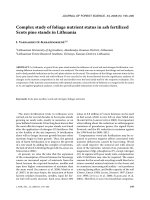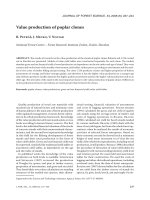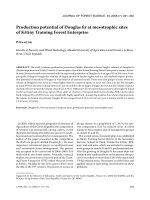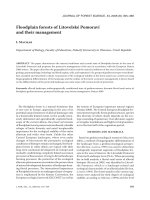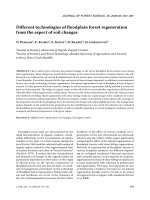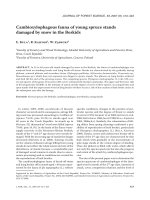Báo cáo lâm nghiệp: "Habitat distribution of dipterocarp species in the Leyte Cordillera: an indicator for species – site suitability in local reforestation programs" ppt
Bạn đang xem bản rút gọn của tài liệu. Xem và tải ngay bản đầy đủ của tài liệu tại đây (988.36 KB, 8 trang )
149
Ann. For. Sci. 63 (2006) 149–156
© INRA, EDP Sciences, 2006
DOI: 10.1051/forest:2005107
Original article
Habitat distribution of dipterocarp species in the Leyte Cordillera:
an indicator for species – site suitability in local reforestation programs
Gerhard LANGENBERGER*
Institute of Plant Production and Agroecology in the Tropics and Subtropics (380b), University of Hohenheim, 70593 Stuttgart, Germany
(Received 17 January 2005; accepted 6 July 2005)
Abstract – Dipterocarpaceae is the most important family of economic trees in southeast Asia. In the Philippines, most dipterocarp forests
have vanished due to logging, shifting cultivation and transformation into settlements or agricultural fields. With an increasing interest for
native tree species in land rehabilitation and reforestation, the need to identify the still available species resources as well as their habitat
preferences arises. I analysed vegetation data from the Leyte Cordillera on the island of Leyte, Philippines, to document the occurrence and
habitat distribution of dipterocarp species. A total of 18 species belonging to the six Philippine dipterocarp genera and representing all eight
Philippine dipterocarp timber groups were encountered. Distinct habitat distribution patterns and elevational ranges could be observed, that
could serve as baseline information for ensuring species-site suitability in local reforestation and tree plantation programs.
Dipterocarpaceae / land rehabilitation / native species / Philippines / reforestation
Résumé – Distribution écologique des espèces de Dipterocarpaceae dans la Cordillère de Leyte (Philippines) : un guide pour le choix
d’espèces bien adaptées aux conditions du milieu dans les projets locaux de reboisement. Les Dipterocarpaceae représentent la famille la
plus importante d’arbres d’intérêt économique en Asie du Sud-Est. Aux Philippines, la plupart des forêts à Dipterocarpaceae ont disparu sous
les effets conjugués de l’exploitation forestière, de l’agriculture « itinérante » et de l’augmentation des surfaces agricoles et des zones habitées.
L’intérêt croissant pour l’utilisation d’espèces indigènes dans les programmes de reboisement rend de plus en plus nécessaire l’identification
des ressources en espèces indigènes et la caractérisation de leurs amplitudes écologiques. Dans cette étude, j’ai analysé des données sur la
végétation de la Cordillère de Leyte (île de Leyte, Philippines), pour documenter la fréquence d’apparition et la répartition écologique des
espèces de Dipterocarpaceae et pour préciser les habitats préférentiels de ces espèces. Au total, 18 espèces ont été recensées représentant les six
genres et les huit groupes de bois associés aux Diptérocarpaceae rencontrés aux Philippines. Ces espèces présentent des habitats bien distincts
liés, entre autre, aux tranches altitudinales. Ces informations pourront servir de guide pour le choix d’espèces bien adaptées à leur milieu dans
les projets locaux de boisement et de reboisement.
Dipterocarpaceae / restauration des sols / espèce indigène / Philippines / reboisement / exigences écologiques
1. INTRODUCTION
The Dipterocarpaceae are the most important source of tim-
ber in Southeast Asia [19]. This was especially true for the Phil-
ippines, which was famous for the dominance of this family in
its lowland forests, where dipterocarps contributed 94% of the
timber volume [19]. Nowadays, only few remnants of diptero-
carp forests are left in the Philippine archipelago. As of 1999,
the forest cover of the Philippines was estimated at 18.3% of
total land area, and the extent of primary forest at 2.7% [9].
Many formerly forested areas have been logged and trans-
formed into permanent agricultural land and settlements [9].
Additionally, large tracts of logged-over forests and shifting
cultivation areas developed into economically unproductive
grassland due to inappropriate land use practices. Dipterocarp
forest remnants are now generally found in localities where
large-scale logging was not profitable and where access was
hampered by the difficult terrain as in rugged and mountainous
areas. The island of Leyte provides a typical example of this
situation. Forty percent of its land surface is covered by grass-
land and barren land, another 40% by coconut plantations [6].
Only 2% of the island is still covered by primary forest [5].
Despite their predominant role in forest exploitation dipte-
rocarps have never played a significant role in reforestation or
land rehabilitation. Instead, exotic tree species have long been
– and still often are – the preferred choice [7]. The use of native
tree species however receives increasing attention [4, 8, 14], but
in practice, such use is hampered by the fragmentary ecological
knowledge of native species – including dipterocarps.
The objective of this paper is therefore to promote the suc-
cessful and sustainable application of this important native tim-
ber group by documenting the locally still available species
resources of this family as well as their distribution and habitat
preferences.
* Corresponding author:
Article published by EDP Sciences and available at or />150 G. Langenberger
2. LOCATION AND ENVIRONMENTAL FACTORS
The island of Leyte belongs to the Eastern Visayas and is
the eighth largest island of the Philippine archipelago (Fig. 1).
It is located between 9° 55' and 11° 48' northern latitude and
124° 17' to 125° 18' eastern longitude. Its characteristic feature
is the Leyte Cordillera, a part of the Philippine fault line, which
shows the typical rugged relief of young volcanic areas. Parent
materials for soil formation are andesitic, basaltic and dacitic
flows and breccia [3]. Soils under old growth forest at c. 500 m
a.s.l. in the western foothills of Mt. Pangasugan have been iden-
tified as Andosols [22]. Due to its rugged relief with forested
slopes of c. 30° to sometimes more than 60° and a high clay
content of the soils, the area is prone to landslides.
The local climate as analysed from data from the weather sta-
tion of the Philippine Athmospheric, Geophysical and Astro-
nomical Services Administration (PAGASA, 7 m a.s.l.) on the
campus of the Leyte State University (LSU) shows an average
annual precipitation of 2 586 mm [12]. The wettest months are
November to January with monthly averages of c. 290 mm. The
driest months are March to May with average monthly rainfall
amounts between 95.4 to 132.9 mm. Annual as well as monthly
variability is high. Although the average values are still within
the range for evergreen rain forests as given by Walsh [21],
drought periods occur, especially during El Niño Southern
Oscillation events [12]. While seasonal rainfall patterns can be
assumed to be similar for the lowlands and the mountain range,
it is likely that the precipitation in the vicinity of Mt. Pangas-
ugan’s summit and its slopes is higher than the values measured
at the PAGASA station due to orographic rains. Another impor-
tant environmental factor affecting the vegetation is the occur-
rence of typhoons. Leyte lies on the southernmost typhoon
tracks entering the Philippines [11]. Typhoons are responsible
for excessive rainfalls, which trigger landslides and cause
heavy mechanical damage in the forests through wind throws
and wind breaks. A special feature of the area is a pronounced
'telescope effect' as described by van Steenis [20]: mossy forest
occurs along exposed ridges and summits as low as 900 m a.s.l.
3. METHODS
This analysis is based on vegetation studies I conducted from 1996
to 1998 [12], and 2004 (unpublished). It refers to two data sets: Data
set one consists of 36 plots of 100 m
2
each located in the primary forest
of the western foothills of Mt. Pangasugan, within the forest reserve
of the Leyte State University (LSU). The plots were mainly located
on one foothill locally called “Pananawan”, and covered an elevational
range from 200–530 m a.s.l. Where possible they had been arranged
along a catena from ridge (15 plots) to lower slope (6 plots), through
upper slope (6 plots) and middle slope (9 plots) (Tab. I). Nevertheless,
this was often prevented by the rugged relief and the common land slides.
Tab le I . Distribution of the sampling plots among topographic habitats and elevation classes.
m a.s.l.
Pananawan plots Happy Valley plots
Total
Ridge Upper slope Middle slope Lower slope Undulating plateau
50–150 –
> 150–250 1 1 2 4
> 250–350 4 2 1 7
> 350–450 2 2 4 3 11
> 450–550 8 4 2 14
~650–700 21 21
Total 15 6 9 6 21 57
Figure 1. The Philippine archipelago and the location of Leyte.
Habitat distribution of dipterocarp species 151
The second data set consists of 21 plots of 100 m
2
each in the south-
eastern outliers of Mt. Pangasugan. The area belongs to the “Commu-
nity Based Forestry Management Area” (CBFMA) of the Cienda San
Vicente Farmer Association and has been specified as part of an area
locally called “Happy Valley”. The plots were located between 647 m
and 709 m a.s.l. in a homogenous old growth forest dominated by
large, up to 40 m tall Shorea polysperma trees. The relief was very
distinct compared to the Pananawan area. The locality can be
described as a semicircular, gently undulating plateau sloping towards
the south and being abruptly demarcated by a deeply incised river sys-
tem which forms the south, west, and north boundary of the plateau.
A clearcut demarcation of relief types as in the “Pananawan” plots was
not possible.
Plot sampling included the assessment of abundance and coverage
of all vascular plants except crown epiphytes. Plants taller than 2.5 m
were assessed within the whole 10 m × 10 m plots, and plants > 0.5
up to 2.5 m tall as well as climbers in 5 m × 5 m sub-plots. For this
analysis plots have vertically been stratified into five height layers: T1
(“canopy layer”) represented the dominant and tallest trees whose
crowns were fully exposed to the sunlight. T2 (“sub-canopy layer”)
were those trees taller than two-thirds the height of the dominant trees
(T1), but which did not (yet) reach the canopy and full exposure to sun-
light. T3 (“middle layer”) comprised trees taller than one-third and up
to two-thirds of T1, and T4 (“lower tree layer”) was defined as being
taller than 2.5 m up to T4. U2 comprised the undergrowth > 0.5 up to
2.5 m tall.
Identification of species is based on the available literature [1, 10,
15, 18] as well as the comparison of specimens with collections of the
Philippine National Herbarium in Manila (PNH), Philippines, and the
National Herbarium of the Netherlands in Leiden (L). Voucher spec-
imens are deposited at the Leyte State University Herbarium, Depart-
ment of Biological Sciences, ViSCA, Baybay, 6521 A, Leyte,
Philippines. For a more detailed description of the methodology see
Langenberger [12].
The “Pananawan” plots were distributed along the whole foothill
and represent a wide amplitude of environmental variability concerning
elevation and relief. On the contrary, the “Happy Valley” plots were
located within one homogenous old growth forest stand reflecting
small scale habitat differences rather than relief types. Observations
on the occurrence and distribution of dipterocarps outside the plots are
considered if they provide additional information. Species frequency
(Fig. 2) is based on the sampling plots data, while the elevational dis-
tribution of the species (Fig. 3) includes specimens occasionally col-
lected outside the plots. As mean the median value has been used since
the number of species occurrences was low. To calculate the box plots
in Figure 3 the computer program SigmaPlot 5.0 by SPSS Inc. has been
used.
For the analysis of habitat preferences (Tab. II) the data from the
“Pananawan” plots and observations in the western foothills of Mt.
Pangasugan have been considered using the different relief types
(“ridge, upper slope, middle slope, lower slope”) while the “Happy
Valley” plots have been assigned to a single “habitat”, which was named
“undulating plateau”. Since the “Happy Valley” plots represented
rather homogenous habitat conditions compared to the “Pananawan”
plots, the application of the relief types would have been misleading.
Additionally, the distribution of the most common species in the
five height strata is given (Fig. 4) and the population structure of these
species is analysed.
Figure 2. Frequency of dipterocarp species in the two data sets from the Leyte Cordillera at Mt. Pangasugan, Leyte, Philippines.
152 G. Langenberger
Figure 3. Observed elevational range of dipterocarp species in the Leyte Cordillera, at Mt. Pangasugan and vicinity, Leyte, Philippines. The
numbers behind the species names refer to the number of observations. The number of dots not always correlates with the number of observations
since one dot can represent several observations at the same elevation.
Figure 4. Representation of the six most common dipterocarp species in five height layers distinguished in the “Pananawan” and “Happy Valley”
plots. Individuals encountered in 57 plots; layers T1–T4 represent 100 m
2
plots, U2 subplots of 25 m
2
; T1: dominant tree layer, T2: > 2/3 of
the stand height but not yet being dominant, T3: > 1/3 – 2/3 of the stand height, T4: > 2.5 m – 1/3 of the stand height, U2: > 0.5 m – 2.5 m.
Habitat distribution of dipterocarp species 153
4. RESULTS
Based on their occurrence within the sampled plots as well
as encounters during field trips, eighteen dipterocarp species
could be identified at Mt. Pangasugan and its vicinities
(Tab. II). The 18 species belong to the six Philippine diptero-
carp genera and make up 28% of the 65 dipterocarp species [2]
known from the Philippines. Additionally, they represent all
eight dipterocarp timber groups [16]. Six species were not yet
described for the island of Leyte (Tab. II). One species, Shorea
cf. hopeifolia, needs further confirmation based on fertile col-
lections, since its occurrence is only described for parts of
Mindanao, so far [1, 13].
The species showed distinct distribution patterns, some
being common and widely distributed while others occurring
only locally or even being encountered only once (Dipterocar-
pus gracilis) or twice (Shorea cf. hopeifolia), thus not allowing
any generalizations.
In the “Pananawan” plots, 16 out of the 18 species were rep-
resented. The most frequent species was Vatica mangachapui,
which occurred in 56% (20) of the 36 plots (Fig. 2). With
decreasing frequency followed 11 species, while three species
could be found in one plot (3%), only. The additional two spe-
cies, Dipterocarpus gracilis and Shorea cf. hopeifolia, have
also been observed in the western foothills but outside the plots.
The “Happy Valley” plots included only three dipterocarp spe-
cies, Shorea polysperma, Shorea palosapis, and Vatica man-
gachapui. Shorea polysperma was by far the most frequent
species, occurring in 76% (16 plots) of the 21 plots, followed
by Vatica mangachapui with 52% (11 plots), and S. palosapis
with 29% (6 plots). No other dipterocarp species was found in
the “Happy Valley” area.
Table II. Occurrence patterns of the dipterocarp species encountered in the Leyte Cordillera at Mt. Pangasugan, Leyte, Philippines
1
.
Species
2
Common official
name
3
Timber group
4
Ridge Upper
Slope
Middle
Slope
Lower
Slope
Undulating
Plateau
Abundance
5
Hopea plagata (Blco.) Vid.
(+)
Yakal-saplungan Yakal ** ³ Loc. common
Shorea polysperma (Blco.) Merr. Tangile Philippine Mahogany -
red lauan
**** * **
****
Common
Vatica mangachapui Blco. Narig Narig **** ***** ** * *** Common
Hopea malibato Foxw. ex Elm.
(+)
Yakal-kaliot Yakal **** ***** ** * Loc. common
Shorea contorta Vid. White lauan Philippine Mahogany -
white lauan
** *** *** Common
Shorea falciferoides Foxw. Yakal-yamban Yakal * *** * * Loc. common
Hopea philippinensis Dyer Gisok-gisok Manggachapui * * * ³ Loc. common
Anisoptera thurifera Foxw.
(+)
Palosapis Palosapis * ³³ Scattered
Parashorea malaanonan (Blco.) Merr. Bagtikan Philippine Mahogany -
white lauan
* *** * Common
Shorea almon Foxw. Almon Philippine Mahogany -
white lauan
* ** * Common
Shorea guiso (Blco.) Bl. Guijo Guijo ** * Loc. common
Hopea acuminata Merr. Manggachapui Manggachapui * ³ * Scattered
Shorea palosapis (Blco.) Merr. Mayapis Philippine Mahogany -
white lauan
** ** ** ** Common
Shorea assamica Dyer Manggasinoro Manggasinoro * ³³ Rare
Shorea astylosa Foxw.
(+)
Yakal Yakal * Rare
Dipterocarpus gracilis Bl.
(+)
Panau Apitong ³ Very rare
Shorea cf. hopeifolia (Heim) Sym.
6
(+)
Kalunti Manggasinoro ³ Very rare
Dipterocarpus validus Bl. Hagakhak Apitong ³³ Scattered
1
Relief types ‘Ridge’, ‘Upper Slope’, ‘Middle Slope’, and ‘Lower Slope’ refer to the occurrence in the ‘Pananawan’ plots, the ‘Undulating Plateau’ to
the ‘Happy Valley’ plots. Frequency figures, symbolized by *, represent encounters within the plots of the different relief types: * ≤ 20%, ** 21–40%,
*** 41–60%, **** 61–80%, ***** 81–100%. Observations on the occurrence of the species outside the ‘Pananawan’ plots are marked with an ³.
2
Species followed by (+) are new descriptions for Leyte based on information given in [1, 10, 13, 15].
3
After [17]; common official names do not necessarily reflect a corresponding application of these names by local people.
4
After [16].
5
The abundance gives a qualitative assessment of the distribution pattern of the species.
6
The identification is based on a juvenile plant; confirmation based on fertile specimens is necessary.
154 G. Langenberger
The elevational range as well as habitat preferences of spe-
cies are given in Figure 3 and Table II, respectively.
The highest elevation of dipterocarps observed during field
work was that for Shorea palosapis and Shorea polysperma
(Fig. 3). Both species could be found as medium sized trees at
850 m a.s.l. on an east-exposed slope of Mt. Imig, only about
50 m below the summit which was covered by mossy forest.
The potential of both species to grow at relatively high eleva-
tion is confirmed by their presence, together with Vatica man-
gachapui, in the “Happy Valley” plots. The lowest elevation
where dipterocarps have been found is at about 100 m a.s.l.
(Fig. 3) along small streams. They were juveniles of Shorea
palosapis and Parashorea malaanonan, which obviously had
resulted from fruits washed down from higher elevations, since
no mother trees could be observed nearby or on the slopes above
the specimens. Nevertheless, medium sized trees of both spe-
cies have been observed at similarly low elevations at other
localities within the area which shows that the species are able
to establish at those elevations.
The widest elevational range showed Shorea palosapis
which could be encountered from the lowland (120 m a.s.l.) to
submontane elevations (850 m a.s.l.). Compared to the other
two species showing a wide elevational amplitude and reaching
high up, Shorea polysperma and Vatica mangachapui, it pre-
ferred slope habitats and could not be found along ridges, while
Shorea polysperma clearly preferred the ridge habitat (“Panan-
awan” plots) and the undulating plateau at “Happy Valley”.
Vatica mangachapui had its main distribution rather on the
upper slope than on the ridge itself.
All other species have been encountered in the western foot-
hills of Mt. Pangasugan, none of them higher than the highest
plot there (530 m a.s.l.). From those species Parashorea
malaanonan and – to a lesser extend – Shorea contorta and Sho-
rea almon also showed a comparatively wide elevational range.
While Parashorea malaanonan and Shorea almon have most
often been encountered on the middle slope, Shorea contorta
was also common on the upper slope and along the ridge. Sho-
rea almon mostly occurred together with Shorea palosapis.
A similar habitat preference as Vatica mangachapui could
be observed with Hopea malibato, although this species was
only locally common and had a much lower elevational ampli-
tude. Like Vatica mangachapui it preferred ridge and espe-
cially upper slope habitats.
A typical low elevation species (which is not represented in
Figure 3 because of its absence from plots and lack of eleva-
tional data) was Dipterocarpus validus
. Mature individuals of
this species could be found scattered along creeks in deforested
areas between 100 m and 250 m a.s.l. All other species were
too poorly represented to draw general conclusions.
The regeneration patterns of the five most frequent species
is shown in Figure 4, based on the number of individuals rep-
resented in the five height layers. The smallest size class (U2)
is usually best represented, although this is less pronounced in
P. malaanonan and Shorea polysperma. But, only Vatica man-
gachapui shows a continuous decrease of individuals from the
U2 layer via the different size classes towards the mature trees
(T1). Shorea polysperma even shows an inverse trend, showing
an increase of individuals with increasing height.
5. DISCUSSION
The studied part of the Leyte Cordillera harbors at least 28%
of the Philippine dipterocarp species and represents all Philip-
pine dipterocarp timber groups (Tab. II). It can provide the nec-
essary seeds and seedlings to establish reforestations and to
meet the various timber requirements of local people in the
future.
Most of the species show distinct altitudinal ranges as well
as marked topographic habitat preferences (Fig. 3 and Tab. II).
This is not a new observation to practical foresters in the tropics
as well as outside the tropics. Nevertheless, the question of trop-
ical trees being stochastically distributed or not is still contro-
versially discussed. Such rugged landscapes as the Leyte
Cordillera in which the influential factors are much more pro-
nounced and obvious than in more homogenous areas allow
quite distinct distribution patterns that seem unlikely to be the
result of a chance process.
The information on tree species-site preferences is important
if such species are planned to be used in reforestation. The pre-
sented data on site-specificity are mainly based on a very small
section of the Leyte Cordillera resulting in only few observa-
tions for rare or scattered species. More information is needed
for the definition of their habitat preferences and elevational
ranges. Additionally, more data from the eastern slopes of Mt.
Pangasugan and the rest of the Leyte Cordillera is desirable.
When evaluating the species’ occurrence at lower elevations
in the western foothills of Mt. Pangasugan, the strong human
impact must be considered. Especially some of the very rare
species can be assumed to be remnants of the former forest of
the coastal plain. Parashorea malaanonan, Shorea palosapis,
Shorea polysperma, and Vatica mangachapui can be classified
as common and widespread. The species Hopea plagata,
Hopea malibato, or Hopea philippinensis are locally common.
Anisoptera thurifera and Shorea assamica must be classified
as scattered (Tab. II). The occurrence patterns of the above
mentioned species have been similarly described by other
authors [1, 23, 24]. Although those species might have lost the
lower range of their habitat due to land conversion in the low-
lands, they still find suited ecological niches within the studied
area. For Hopea acuminata and Hopea philippinensis, which
show a low frequency as well as a clustered occurrence, their
real elevational potential cannot be given based on the available
data. For Shorea assamica, which is also represented by few
observations, it is quite safe to conclude that it prefers lower
elevations since the four observations are derived from different
localities.
The evaluation of those species which are scattered or rare
is more difficult. Dipterocarpus validus is well known for its
occurrence on flood plains and along rivers at low elevations
[18, 23, 24]. Its occurrence in the lower foothills of Mt. Pan-
gasugan clearly represents fragments of its former distribution,
and it can be safely concluded that the species lost most of its
potential habitat. It is unusual that single mature forest trees can
still be found in an otherwise deforested landscape. One expla-
nation might be that these trees, which grow along the river
banks or on the banks of small ravines which are usually not
cleared for shifting cultivation, had not reached a harvestable size
when the cutting of trees was not yet restricted and controlled.
Habitat distribution of dipterocarp species 155
Nowadays, a logging ban prohibits the cutting of trees, and it
is difficult to cut a tree unobserved in the highly populated and
frequented lowlands. Much more critical is the situation of Dip-
terocarpus gracilis. Although it can be assumed that besides
the single juvenile specimen encountered some mature trees
might be left, this species may be classified as locally extremely
rare and vulnerable. But to what extent its rarity reflects human
impact or is natural is again difficult to evaluate. Ashton [1]
describes the species as very widespread, and even gregarious
under seasonal conditions, while it gets rare in ever wet areas.
This shows how difficult a qualitative evaluation of species
occurrence is without having sound historical data.
The observation of only three dipterocarp species in the
“Happy Valley” area is remarkable, especially since even
around the field camp, which was located at the foot of the pla-
teau (500 m a.s.l.), along a small creek, no additional diptero-
carp species has been encountered. It confirms the assumption
that many of the species so far only observed on the western
side of the mountain range are actually typical species of the
coastal plains which found their refuge in the rugged western
foothills of Mt. Pangasugan. The dominant role of Shorea
polysperma in the “Happy Valley” plots (649–709 m a.s.l.) has
been mentioned above. Vatica mangachapui was also a com-
mon feature represented by mature individuals. On the con-
trary, Shorea palosapis, which was represented by tall
individuals near the field camp and on the lower slopes along
the river was only poorly represented in the plots, and the few
individuals found there represented small to medium sized
trees. This supports the impression that the species strictly pre-
fers very humid conditions, and that, on the other hand, the
stand where the “Happy Valley” plots have been sampled rep-
resents comparatively dry conditions.
It can be concluded that for those species which prefer
medium to higher elevations or show a wide range of eleva-
tional occurrence the studied area is an important stronghold
for the conservation of their populations and their genetic diver-
sity. This is the case with Parashorea malaanonan, Shorea
contorta, Shorea palosapis, Shorea polysperma, and Vatica
mangachapui. For Shorea polysperma it might even be con-
cluded that it still occupies its full potential range. For those
species which are scattered or rare the area also acts as a refuge.
But their populations are naturally more vulnerable concerning
the loss of individuals due to illegal logging or shifting culti-
vation, simply because of their low abundance.
Although much more specific and comprehensive data are
desirable to define habitat preferences of the local dipterocarp
species the above analysis provides important baseline infor-
mation. Even though it might be possible to plant species suc-
cessfully in other habitats, when competition is suppressed, the
question arises if this would be sustainable on the long run.
Considering the dynamics of tropical rain forest environments
this can be doubted. Unfortunately, detailed documentation and
analysis of reforestation trials with native species are hardly
available – if they exist at all. Usually, in national statistics only
the area which has been planted is listed. If planting has been
successful and sustainable after five or ten years can rarely be
found. Systematic scientific trials to test the site specific suit-
ability of species or even provenances for reforestation or land
rehabilitation as they have been conducted e.g. in Europe for
decades seem illusionary given the economic situation of most
tropical rain forest countries. They are even not practical con-
sidering the urgent needs for reforestation and land rehabilita-
tion in so many areas of the tropics. Therefore, if native species
are to be promoted, the only practical way to reduce the risks
of failure due to the selection of unsuited habitats is to stick to
observations on the natural occurrence of the species.
Acknowledgements: The vegetation study in the western foothills of
Mt. Pangasugan has been conducted in the framework of the “ViSCA-
gtz Applied Tropical Ecology Program” (PN 95.2290.5-001.00). The
additional research in the “Happy Valley” area has been made possible
by a grant of the A.F.W. Schimper Foundation, Stuttgart - Hohenheim,
Germany, whom I owe special thanks. I am very grateful to the Cienda
San Vicente Farmer Association as well as the Leyte State University
(LSU), Leyte, Philippines, for their cooperation and support. Thanks
are also due to Nina Ingle and the two anonymous reviewers for their
helpful comments.
REFERENCES
[1] Ashton P.S., Dipterocarpaceae, in: van Steenis C.G.G.J. (Ed.),
Flora Malesiana Series I, Vol. 9 (2), Martinus Nijhoff Publishers,
The Hague, The Netherlands, 1982, pp. 237–552.
[2] Ashton P.S., Philippine phytogeography, Asia Life Sci. 2 (1993) 1–8.
[3] Asio V., Characteristics, Weathering, Formation and Degradation
of Soils from Volcanic Rocks in Leyte, Philippines, Hohenheimer
Bodenkundliche Hefte 33, Univ. Hohenheim, Institut für Boden-
kunde und Standortslehre, Stuttgart, 1996.
[4] Butterfield R.P., Fisher R.F., Untapped potential: native species for
reforestation, J. For. 92 (1994) 37–40.
[5] Dargantes B.B., Koch W., Case studies on the occupation and cul-
tivation of the forest lands of Leyte, Philippines, Ann. Trop. Res. 16
(1994) 13–29.
[6] DENR, Philippine atlas, Department of Environment and Natural
Resources (DENR), Quezon City, The Philippines, 1998.
[7] Dias C.P., ERDB’s research and development (R&D) experience(s)
in reforestation with Philippine native tree species, in: Margraf J.,
Göltenboth F., Milan P.P. (Eds.), Proceedings on the International
Conference on Reforestation with Philippine Species – for biodi-
versity protection and economic progress, 3–6 March 1997, MacAr-
thur Beach Resort, Palo, Leyte, Philippines, 1997, pp. 156–174.
[8] Elliot S., Blakesley D., Anusarnsunthorn V. (Eds.), Forests for the
future: growing and planting native trees for restoring forest eco-
systems, Forest Restoration Research Unit, Biology Department,
Faculty of Science, Chiang Mai University, Chiang Mai 50200,
Thailand, 1998.
[9] ESSC, Decline of the Philippine Forest, Environmental Science for
Social Change, Inc., The Bookmark, Inc., Makati City, The Philip-
pines, 1999.
[10] Guzman E.D. de, Umali R.M., Sotalbo E.D., Guide to Philippine
Flora and Fauna, Vol. 3: Dipterocarps, Non-Dipterocarps, Natural
Resources Management Center, Ministry of Natural Resources &
University of the Philippines, 1986.
[11] Kintanar R.L., Climate of the Philippines, PAGASA, Quezon City,
Philippines, 1984.
[12] Langenberger G., Diversität, Struktur und Reliefabhängigkeit der
Vegetation in einem Tieflandregenwald der Insel Leyte, Philippi-
nen, Dissertation, Institut für Pflanzenproduktion und Agrarökolo-
gie der Tropen und Subtropen (380), Universität Hohenheim, 2003.
[13] Merrill E.D., An Enumeration of Philippine Flowering Plants, Vol.
I-IV, The Government of the Philippine Islands, Department of
156 G. Langenberger
Agriculture and Natural Resources, Bureau of Science, Manila,
1923–1926.
[14] Milan P.P., Margraf J., Rainforestation farming, an alternative to
conventional concepts, Proc. Sustainable Alternative Livelihood
Project Symposium, Quezon City, Philippines, November 10–11,
1994.
[15] Newman M.F., Burgess P.F., Whitmore T.C., Manuals of Diptero-
carps for Foresters: Philippines, Center for International Forestry
Research, Jakarta, Indonesia, 1996.
[16] PCARR, The Philippines Recommends for Dipterocarps: I. Lum-
ber, Forest Products Research and Industries Development Com-
mission (FORPRIDECOM), NSDB, College, Laguna, 1977.
[17] Salvosa F.M., Lexicon of Philippine Trees, Forest Products
Research Institute, College, Laguna, Philippines, 1963.
[18] Seeber G., Weidelt H J., Banaag V.S., Dendrological characters of
important forest trees from eastern Mindanao, 2nd ed., Deutsche
Gesellschaft für Technische Zusammenarbeit (GTZ) GmbH, Dag-
Hammarskjöld-Weg 1+2, Postfach 5180, D 6236 Eschborn 1, 1985.
[19] Soerianegara I., Lemmens R.H.M.J., Plant Resources of South-East
Asia, Timber tree: Major commercial timbers, Prosea, Bogor, Indo-
nesia, 1994.
[20] Steenis C.G.G.J. van, The mountain flora of Java, Brill, Leiden,
The Netherlands, 1972.
[21] Walsh R.P.D., Climate, in: Richards P.W. (Ed.), The Tropical Rain
Forest, Cambridge University Press, 1996, pp. 159–205.
[22] Zikeli S., Nutrient status and nutrient cycles of the tropical rainfo-
rest, Mt. Pangasugan, Leyte, Philippines, Diploma thesis at the
Martin Luther University Halle – Wittenberg, Landwirtschaftliche
Fakultät, Inst. für Bodenkunde und Pflanzenernährung, 1998.
[23] Weidelt H.J., Banaag V.S., Aspects of Management and Silvicul-
ture of Philippine Dipterocarp Forests, GTZ Publication No. 132,
TZ Verlagsgesellschaft mbH, 6101 Rossdorf 1, Germany, 1982.
[24] Whitford H.N., The Forests of the Philippines, Part II: the Principal
Forest Trees, Bureau of Forestry Bulletin No. 10, Manila, Bureau
of Printing, 1911.
To access this journal online:
www.edpsciences.org
